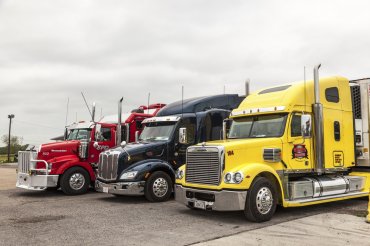
PALM DESERT, California – U.S. trucking fleets shrank the past few years, even as the volume of goods transported is rising, an analyst said at the Independent Lubricant Manufacturers Association Annual Meeting here last week.
Combined with a growing shortage of drivers, the trend explains the challenges that industries such as the lubricants industry are encountering to move products, said Rodrigo Suarez, economic analyst for the American Trucking Association. He added that prices for transport by truck are rising and look likely to continue doing so as fleets and independent drivers strive to keep up with demand.

Photo: Philip Lange/Shutterstock
Trucking company fleet sizes have decreased the past few years as a shortage of drivers means the industry doesn’t have the capacity to meet increased demand.
According to data compiled by the ATA, the number of tractors in large trucking fleets decreased in size by 5 percent in both 2016 and 2017, and were down an additional 1.5 percent through July 2018. Small fleets, which earn fewer than $30 million in annual revenue, actually increased in size by 5.1 percent in 2016 but dropped 0.2 percent in 2017 and 0.6 percent through July 2018.
This is despite the fact that the U.S. economy is in the midst of expansion, and freight tonnage has been steadily rising for years. Tonnage moved by large truckload fleets has increased 45 percent since 2010 and 15 percent since 2014, Suarez said.
Truck sales have even risen the past few years, but that doesnt necessarily correlate to increased fleet sizes. What truck sales dont show us is whats actually going on with capacity, Suarez explained. The average age of Class 8 tractors peaked in 2011 and has since fallen, meaning companies have likely shed their older equipment in favor of newer trucks. Additionally, an increased number of new units are being exported.
Fleet operators have added drivers to their fleets, but a lot of these hires are former independent contractors making the switch to company jobs.
Based on current trends, the driver looks likely to worsen rather than improve. The number one hot topic in our industry is the driver situation, said Suarez. All of this [data] really just screams driver shortage. The ATA estimates about 500,000 for-hire truckload drivers are on the roads, a little over 50,000 short of what the industry needs. If that trend continues, the industry could be about 180,000 drivers short by 2026, though the situation is unlikely to get that desperate. This is just if nothing is done. Things are already getting done. Its probably not going in this direction, explained Suarez.
To illustrate the paltry pace at which the trucking industry has hired, Suarez cited U.S. Department of Labor statistics that the manufacturing and construction sectors created 400,000 and 420,000 new jobs, respectively, since 2017. Over the same period, for-hire trucking created just 30,000.
Now the industry must confront the fact that 45 percent of truck drivers in the U.S. are between the ages of 45 and 54, and 20 percent are between 55 and 64 years old. Only approximately 5 percent of drivers are between the ages of 20 and 24.
As competition for trucking resources heats up, prices are rising. Suarez said that driver wages rose in almost every segment of the industry from 2013 to 2017, in many cases by over $10,000 per year.
Some U.S. Congress people are trying to help address the issue. The HR5358 Drive Safe Act introduced in the U.S. House of Representatives would lower the minimum age for truckers crossing state lines to 18, while introducing requirements that young drivers amass 400 hours of apprenticeship that includes experienced drivers riding with them.
Suarez said freight shippers can also help the situation by reducing driver waiting times. Allowing a driver to get into a warehouse, pick up cargo and get out as quickly as possible enables existing resources to cover more miles. The average driver covers 8,500 miles a month. If shippers can reduce waiting times, just a little bit, and those truck drivers can get just an extra 500 miles, thats almost a 6 percent increase in added capacity without adding a single truck, he said.
Recruiting more female drivers would also help. Only 6 percent of drivers are female, said Suarez, though at some companies female drivers comprise up to 20 percent of their workforce.